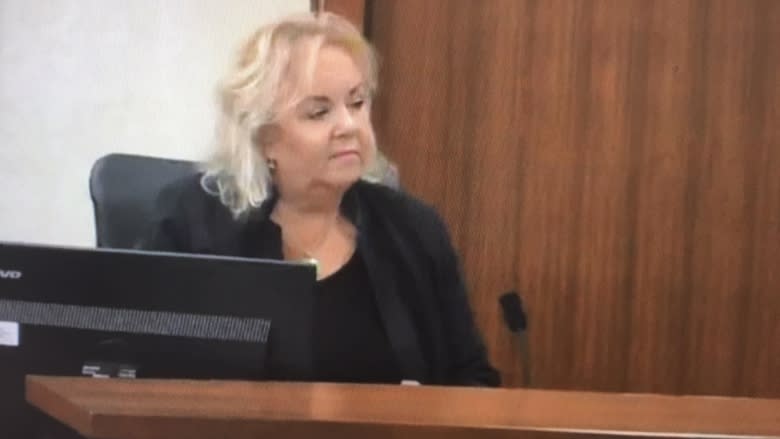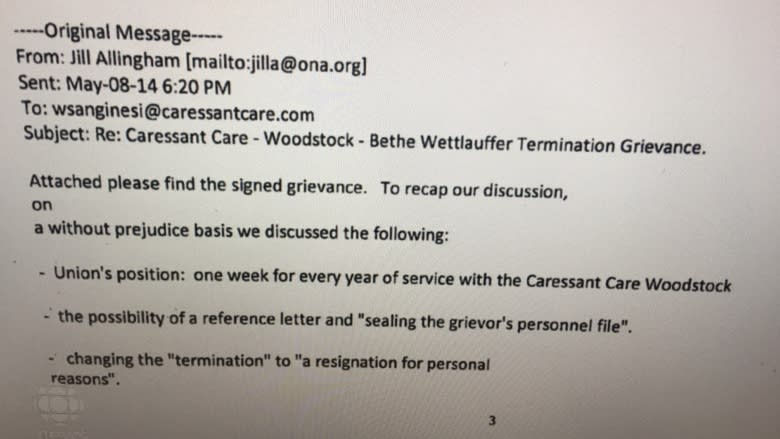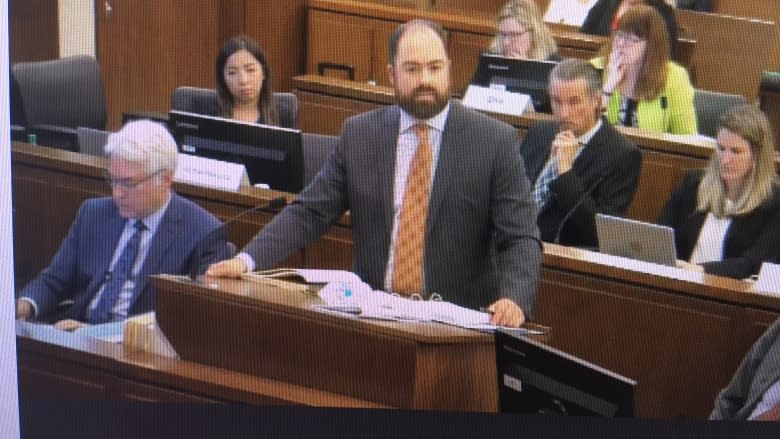'She fooled everybody,' nursing home boss says about serial killer Wettlaufer
When they were finally considering firing nurse Elizabeth Wettlaufer, top executives at the Caressant Care nursing home in Woodstock, Ont., agreed she was "a danger to resident safety."
The medication errors she was making were "very dangerous," the home's chief financial officer wrote in a 2014 email that was shown at the public inquiry into long-term care on Thursday.
But the nurse's firing was grieved right away by her union, the Ontario Nurses' Association (ONA), and Caressant Care wanted to settle the matter instead of taking it to arbitration, which would cost a lot of money.
If Caressant Care lost the arbitration, it would not only have to pay for the cost of an arbitrator, but also pay Wettlaufer her back wages and reinstate her.
Instead, Wanda Sanginesi, the home's vice-president of human resources, testified that she began settlement proceedings with the ONA, which eventually led to a $2,000 tax-free "nuisance fee," a letter of reference and a sealed employment file.
"We thought we had as good a case [to fire her] as we would likely have, but it had vulnerabilities," said Sanginesi.
She said the home was hamstrung by parts of the collective agreement and that if Wettlaufer wasn't in a union, she would have been fired a lot sooner.
But Kate Hughes, the lawyer for the union, took Sanginesi to task, arguing Caressant Care had information about Wettlaufer's poor performance, her obsessive compulsive disorder and her bipolar condition that it didn't share with the union.
"There was information that [Caressant Care's administrator] didn't share with you, and there was information that you didn't share with [the union]," Hughes told Sanginesi.
"So we now know she was a serial killer. She fooled [the director of care] and she fooled [the administrator]," Hughes said.
"I think she fooled everybody," Sanginesi replied.
'Intent to kill'
Sanginesi also admitted that she destroyed any notes she took at the time, as she usually does when an employment matter is resolved.
"But it's labour law 101, take notes during meetings," Hughes told her.
"The union was left with the impression that Ms. Wettlaufer was a good employee until 2012, with some sporadic problems but no issues with safety concerns," Hughes said.
"If Elizabeth Wettlaufer had not been in a union, she would still be able to access insulin, she would still be left alone with residents on the night shift," Hughes said. "The fact that she was unionized or not unionized had no bearing on her intent to kill."
Caressant, union spar over details
The inquest later heard from Jill Allingham, a labour relations officer who handled Wettlaufer's file for the ONA.
After being pressed by a lawyer representing Caressant Care, Allingham said the union did not conduct an investigation into Wettlaufer's job performance before grieving a five-day suspension for medication administration errors.
In fact, it took only hours for the ONA to file its notice of grievance after Wettlaufer alerted the union about the suspension.
Asked if she consulted anyone within the ONA with nursing expertise, Allingham replied: "I didn't consult."
The grievance eventually led to Wettlaufer being granted a $2,000 settlement deal and a reference letter from Caressant Care that did not reference any wrongdoing.
Allingham had earlier called the revelation that Wettlaufer killed patients "absolutely shocking."
"How did [we] not realize something was happening here?" she asked.
Settlement deal not followed
As part of her settlement deal, Wettlaufer's personnel file was sealed, and all calls for references from prospective employers were supposed to go to Sanginesi.
But twice employers called Caressant Care and were put through to a different manager, who called Wettlaufer "very caring" and "a good team player" with good critical thinking skills who left because of a personality conflict.
And that reference letter, signed by the home's administrator but actually written by Sanginesi, was used by Wettlaufer to show a new boss that she'd been cleared of any wrongdoing at Caressant Care.
Sanginesi said she didn't know of hiring managers ever using reference letters as a guide to hire someone.
The lawyer for one group of victim's families, Alex Van Kralingen, asked Sanginesi why she used the language she did in the letter, which said Caressant Care was "pleased" to give Wettlaufer a reference and wished her well.
"Are you pleased to provide a reference to someone who you knew put patients at risk?" Van Kralingen asked.
"That's boilerplate language," Sanginesi replied.
"Forget boilerplate language. I'm asking you on a human level, are you pleased to provide a reference to someone who was putting residents at risk?"
"I had no expectation that any employer would give any weight to this letter," Sanginesi said.
In fact, Wettlaufer took the letter to a temp agency that had hired her and told her boss, "See, I'm cleared."
She got a job at another care home, and tried to kill another elderly patient.
Inquiry runs until the fall
The Public Inquiry into the Safety and Security of Residents in the Long-Term Care Homes System was established on Aug. 1, 2017, after Wettlaufer was sentenced to eight concurrent life terms. It began hearings on June 5, and is examining how Wettlaufer's crimes went undetected for so long.
Her killing spree began in 2007 and continued until 2016, when she finally confessed to a psychiatrist and a social worker. Until then, her employers, police and Ontario's licensing body for nurses had no idea eight patients had been murdered and six more poisoned with injections of massive doses of insulin.
The inquiry is scheduled to last until September.




